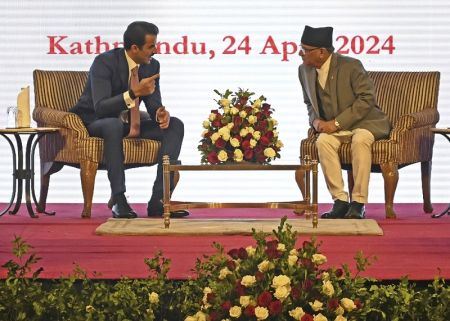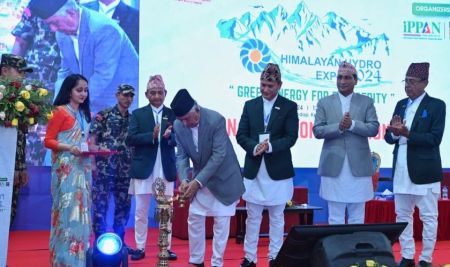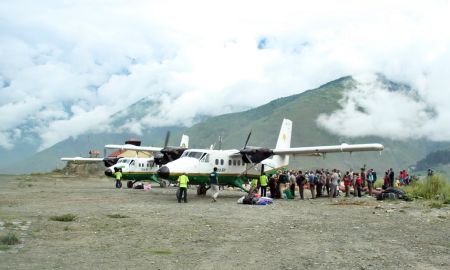 Prof Imon Ghosh is the Director of the Academy of Human Resource Development (AHRD), India’s premier institution specialising in human resources development. Prof Ghosh has a postgraduate degree in Economics with over 28 years of experience in industry and academia. He has identified five prospective new engines of economic growth, which, he claims, can reduce poverty across the developing countries as well as empower the disadvantaged/excluded groups in the developed countries. Recently, he was in Nepal to conduct a leadership workshop. New Business Age caught up with him on the sidelines of the workshop to talk about his idea of new engines for the economic growth and his other works. Excerpts:
Prof Imon Ghosh is the Director of the Academy of Human Resource Development (AHRD), India’s premier institution specialising in human resources development. Prof Ghosh has a postgraduate degree in Economics with over 28 years of experience in industry and academia. He has identified five prospective new engines of economic growth, which, he claims, can reduce poverty across the developing countries as well as empower the disadvantaged/excluded groups in the developed countries. Recently, he was in Nepal to conduct a leadership workshop. New Business Age caught up with him on the sidelines of the workshop to talk about his idea of new engines for the economic growth and his other works. Excerpts: What brought you to Nepal?
This is my first visit to Nepal. Verisk invited me here to conduct a three-day leadership skill workshop for its management and senior management teams. Since I was here, I told my host to make another use of my visit by conducting a talk programme on my idea of new engines of economic growth. The motive of my Nepal visit is to start a discussion on my idea of ‘new engines of economic growth’ here in Nepal. I wanted to invite participants to provide me their inputs on it.
Can you please briefly highlight the idea of new engines of economic growth? What exactly are the new engines that you have identified?
I have identified five engines of economic growth. The first one is leveraging the demographic dividend through better education and skills. This also deals with the fiscal impact of ageing population, and links to deficits. Second is innovative teaching methodologies. This requires the overhaul of our education system from a teacher-centric pedagogy to a learner-centric andragogy, resulting in higher quality human capital that can add greater value to the knowledge economy. The third one is the ship design innovation that can reduce the cost of international trade. Likewise, fourth engine is related to research and development that results in the next generation of propulsion system after jet propulsion. This I have been thinking since the early 1980s. The fifth one is about the actionable ideas to reduce poverty and accelerate economic growth. This explores a new model for promoting financial inclusion, solutions to the current economic downturn, financial sector reforms and accelerating economic growth. My presentation here mostly dwelt on this fifth engine.
How did this idea of new engines of the economic growth evolve?
In 1992, I was doing my Masters in Economics. I came across a news article which said that many rural regional banks were running in losses and the government of India was trying to centralise them and take them to Delhi. My immediate thought was that it was a wrong thing to do; a rural bank should be in the rural area, and 196 such banks are not enough as India has over 600 thousand villages where over 815 million people live. Then I started investigating and looking at the whole when the thought crossed my mind that if we could economically empower 815 million people than we would have a powerful engine of growth. If so many people have the additional spending power, it would lift the economy up. In India, if there is good monsoon, farmers earn more and the stocks (shares price) of Hindustan Liver and other companies go up. Everybody benefits from the prosperity. Nobody benefits from keeping the people poor. It is morally imperative to reach out to the poor and improve their living conditions. As economies around the globe, including those of India and China, decelerate or slip into recession, the need of these new engines of economic growth becomes more urgent.
How can these new engines help accelerate Nepal’s economy?
I am actually here to learn and the purpose of my talk was also to have a conversation. I have studied India and I am interested in Nepal. I cannot prescribe the exact solution to Nepal. So, my intent was to solicit the inputs and feedback into my idea of new engines so that we can co-create it so that the engines could help Nepal’s economy in some way, either completely or remotely. This is not a complete solution, but of course a stepping stone for the economic growth.
What kind of response have you been getting on your idea?
So far, it’s very good. My paper on ‘Reducing Poverty and Accelerating Growth’, which contains this idea, has been included in the syllabus of India’s National University of Juridical Sciences. It was abridged and published on the editorial page of the Times of India, and noted in the records of the Indian parliament. Chief economic Advisor, Minister of Rural Development and other policy makers have appreciated it.
During your presentation, you underlined the need of integration between formal and informal financial sectors for an effective financial system. Could you please explain it?
In the formal financial sector, interest rates are low, the coverage is not very good, capital adequacy is low, and non-performing assets are created right from the very beginning. There are other problems too. In the informal sector, interest rates may be high. For the economy to grow, both should complement with each other and work in tandem.





















